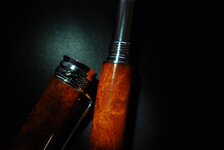candy1land
Member
Alrighty then. Just when I thought I was getting the handle on this CA finish thing......sigh.
I just turned my first piece made out of amboyna burl for my first Majestic JR.
I made it on Saturday and today I just noticed what appears to be eggshell looking cracks all over the lower barrel.
There were also some other scratches near the ends I noticed too but I wrote those off to the pen being in my bag one of the days. In hindsight now I don't think I actually scratched the pen ever. I'm much too careful with it and it lives in a pen pouch when not in my hands....it is my VERY FIRST ONE!
So I took pics, I hope you can see some of what I'm talking about.
Why did this happen? And can it be re-done? I haven't worked with Amboyna before so all helpful hints are welcome. The pen was absolutely beautiful before the cracks showed up. It's one of the pens I want to start selling, but I can't do that until I figure this out. No one will want to purchase a pen like this only to have it crack like an egg on them in the first week of owning it.
Thanks,
Candy
I just turned my first piece made out of amboyna burl for my first Majestic JR.
I made it on Saturday and today I just noticed what appears to be eggshell looking cracks all over the lower barrel.
There were also some other scratches near the ends I noticed too but I wrote those off to the pen being in my bag one of the days. In hindsight now I don't think I actually scratched the pen ever. I'm much too careful with it and it lives in a pen pouch when not in my hands....it is my VERY FIRST ONE!
So I took pics, I hope you can see some of what I'm talking about.
Why did this happen? And can it be re-done? I haven't worked with Amboyna before so all helpful hints are welcome. The pen was absolutely beautiful before the cracks showed up. It's one of the pens I want to start selling, but I can't do that until I figure this out. No one will want to purchase a pen like this only to have it crack like an egg on them in the first week of owning it.
Thanks,
Candy

